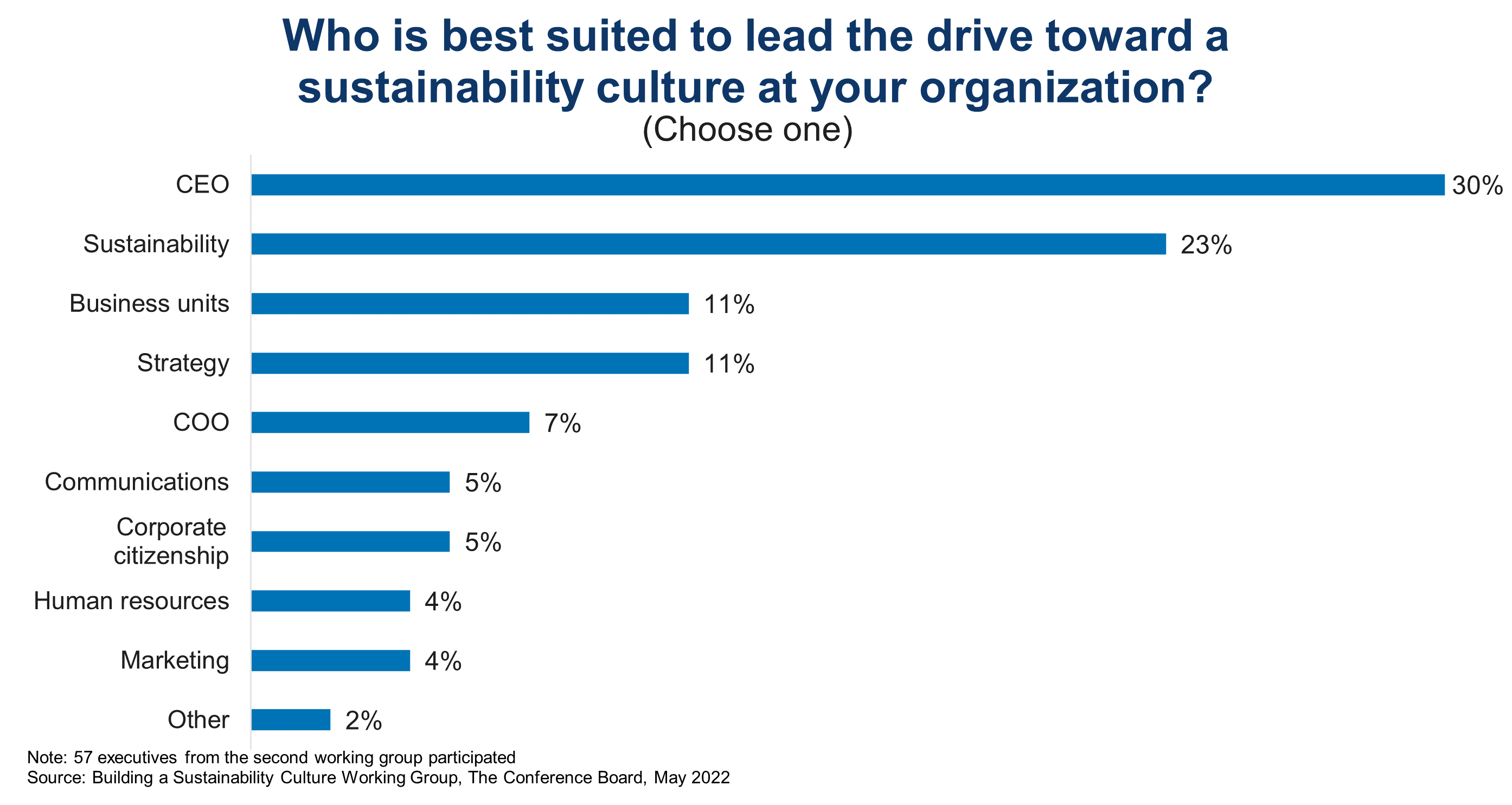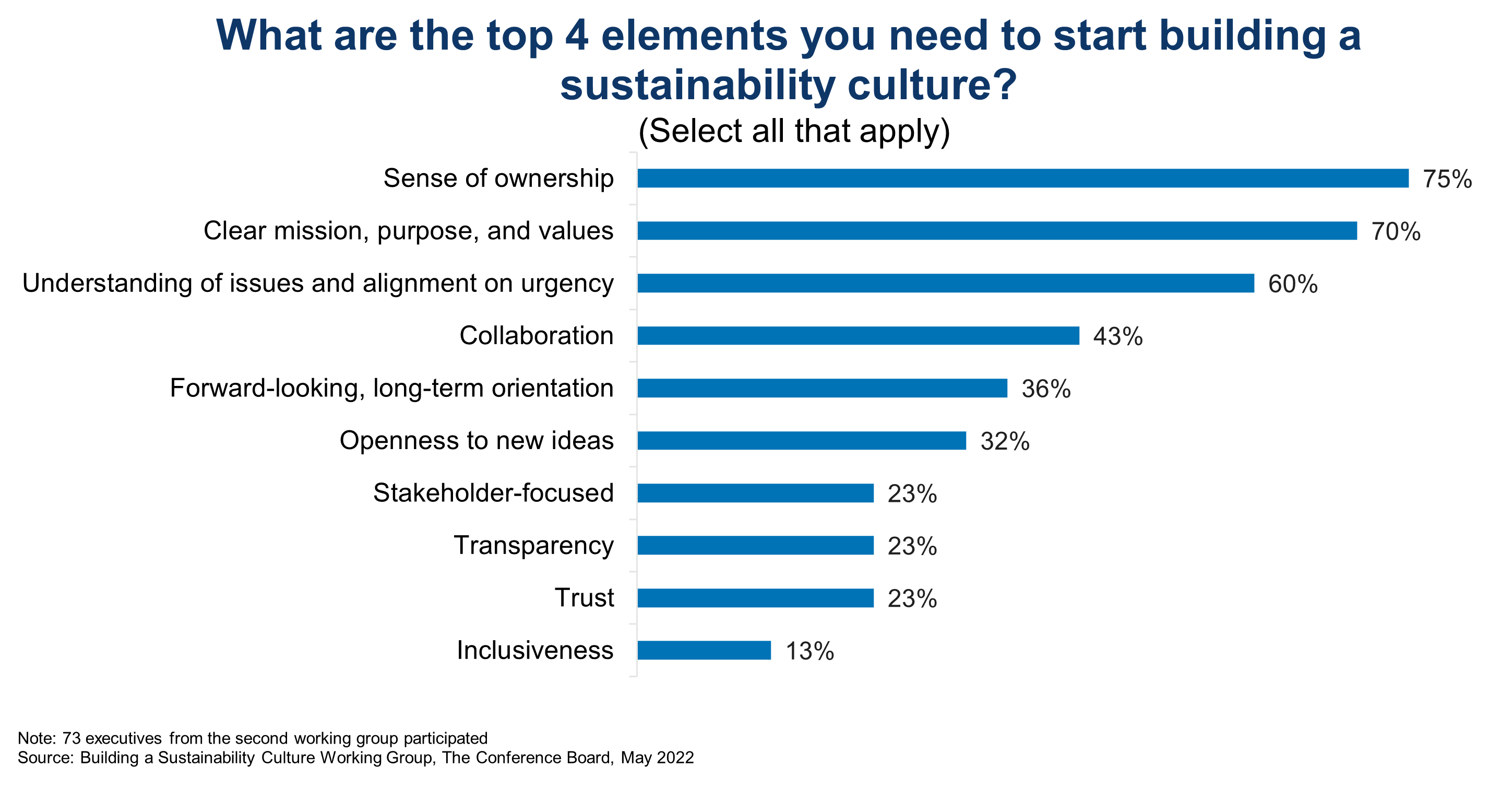Insights for What’s Ahead
Business leaders need to lead the way on this issue.While people may often think of corporate functions (human resources, compliance, corporate communications) as being responsible for a company’s culture, driving sustainability into a company’s DNA requires strong leadership from business executives. Thirty percent of working group participants cited the CEO as best suited to lead the effort, while another 28 percent cited those responsible for the company’s business strategy and operations. Another choice, embraced by 23 percent, was the senior sustainability executive, who is the “chief dot connector” tasked with integrating sustainability into a company’s business strategy and operations. These answers recognize that, to be effective, sustainability cannot be bolted on to a corporate culture, but needs to be built in, based on the company’s business.

Even if one person leads the effort, this is a team endeavor. Fifty-one percent of the participants said that a team of executives is responsible and accountable for leading the effort, recognizing that no single function generally has the wherewithal to champion this effort. Each C-suite executive generally can take the lead with respect to specific stakeholders (e.g., the chief human resources officer for employees, the chief marketing officer for customers, and the chief financial officer for investors), but all need to have a multistakeholder perspective.

It’s extremely helpful to engage outside stakeholders to help drive change. Companies have found that even having the backing of the CEO and C-suite isn’t enough. It’s very powerful for employees to hear directly from investors, customers, and business partners about why they believe sustainability should be a priority for the company. It helps to underscore that there are real business and financial consequences to embracing sustainability. Engaging customers and business partners is also a way to lay the groundwork for collaboration that can drive sustainability-linked business innovation.
Provide opportunities for employees at all levels to help create a sustainability culture. The effort to build a sustainability culture also needs to have a grassroots element to it. Companies succeed when they enlist people across, and at all levels of, the organization to contribute their ideas about what the company can do to advance its sustainability culture. It’s a way of not only harnessing the ingenuity that exists throughout the organization, but also helping to generate the sense of “ownership” that’s so critical.
The human capital function has at least three key roles to play. First, human capital needs to help the organization think through how sustainability intersects with other key features of the company’s actual and desired corporate culture—whether those attributes be inclusivity, flexibility, innovation, meritocracy, or high performance. Second, it can establish and execute programs that specifically support the company’s sustainability goals, including through programs to recruit, train, and reward talent for their efforts. Third, and more broadly, human capital plays a key role in ensuring that the company focuses on the long-term welfare of its workforce. You can only create a durable culture that is focused on the long-term welfare of society and the natural environment if you also take care of your employees.
The communications function is also indispensable—and needs to be brought in at the outset. Communications can help build an internal brand for sustainability efforts, make sustainability something that employees are truly excited to be part of, and create messages that are both relatable and memorable. Getting the most out of the communications function means getting it engaged early in the process as the company identifies priorities so that communication partners have a deep understanding of the issues.
The board can play an important—and sometimes unexpected—role in supporting this cultural change. It’s important to have board support for instilling sustainability into a company’s DNA, in part because efforts need to last beyond the tenure of a single management team. And, as with other key initiatives, boards can play their traditional role in overseeing the implementation of a key program and tracking its progress through the use of dashboards. It can also encourage management to incorporate sustainability into ongoing conversations with investors (e.g., during quarterly earnings calls). But the board also has a more subtle role to play. One of the hallmarks of a sustainability culture is transparency and a willingness to take an unflinching look at current practices. Here, the board can set a tone of transparency in its conversations with management, as well as in an honest self-assessment of its own performance.
Leverage existing management governance structures, but don’t be afraid to experiment. Many companies have existing internal steering committees that help to develop, execute, and communicate the company’s sustainability efforts. These groups can help ensure that the company satisfies the prerequisites to building a sustainability culture, including a clear sense of the company’s sustainability priorities—and a shared sense of urgency. They can also help keep track of a company’s efforts to instill sustainability in the company’s DNA. But given the magnitude of the challenge and opportunity, companies may want to assign responsibility for driving the effort to build a sustainability culture to a smaller subset of the steering committee members who can work directly with the CEO, C-suite executives, and chief sustainability officer.
While building a sustainability culture may promise considerable rewards in greater business innovation, higher employee engagement and retention, and powerful societal impact, it also takes considerable work. It requires leadership by senior business executives; critical contributions by sustainability, human capital, and communications functions; support from the board in both words and deeds; and engagement by employees across the organization.
[1] These four briefs are based on a series of Chatham House Rule working group convenings held by The Conference Board ESG, Human Capital, and Marketing & Communications Centers and sponsored by Baker Tilly. A working group offers members of The Conference Board a venue where they can actively engage on a key topic. It provides members an opportunity for peer-to-peer dialogue to address shared challenges and gives members access to experts, the latest research, benchmarking data, and examples of best practices. The working group Building a Sustainability Culture, organized by The Conference Board ESG, Human Capital, and Marketing & Communications Center, met in March 2022 and May 2022, and will meet again in August and October 2022.


